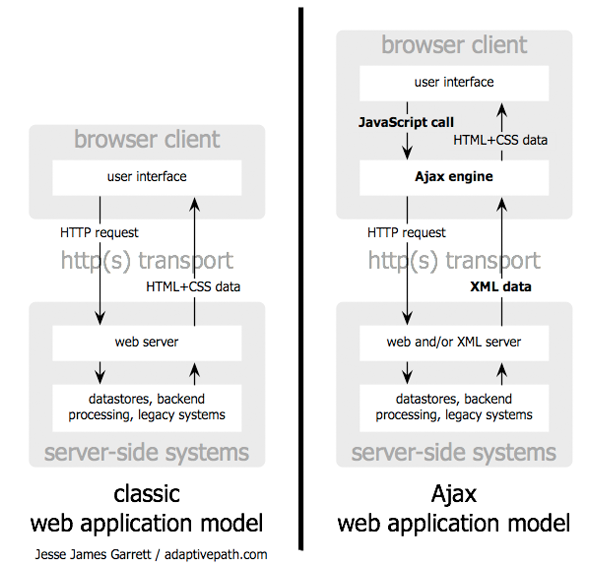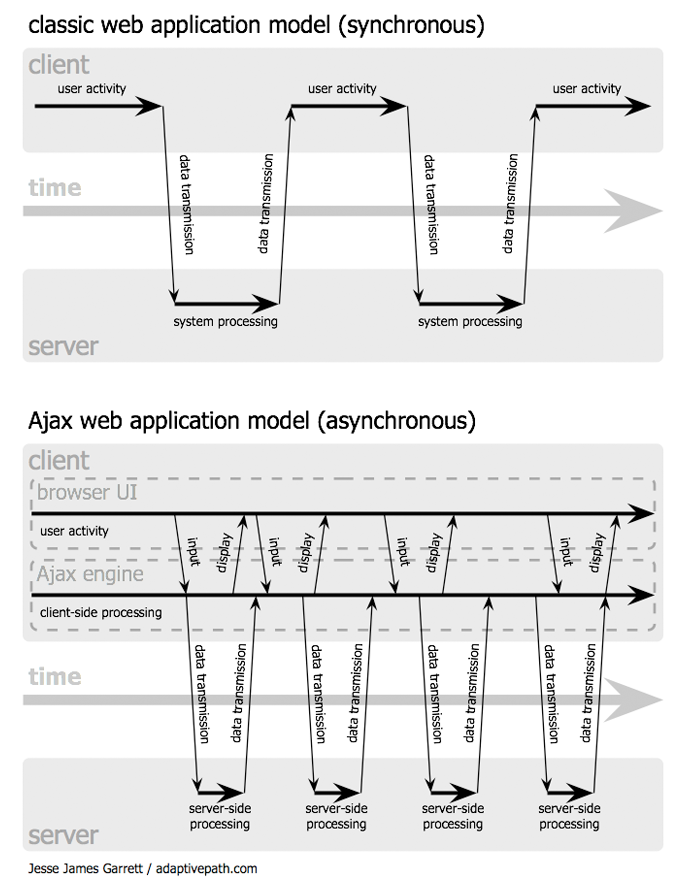This workshop is important because:
AJAX is the means by which we access data from external resources through APIs. In order to make complex web apps, we will need to access data from some of the amazing resources that provide rich, useful data. If you want to integrate maps, social media, live searched images, or any other user controlled data, you're going to need an API and AJAX to access it.
After this workshop, developers will be able to:
- find and read documentation for useful APIs
- give an instance when AJAX would be used in your code
- use AJAX to GET data from an API
- describe the meaning of
method:,url:, andonSuccess:keys in jQuery's$.ajaxsyntax
Before this workshop, developers should already be able to:
- read JSON and access specific attributes of a large piece of JSON.
- explain that callbacks are functions passed around to be executed later.
Go to this piece of JSON. Assume that the entire object returned is called response and answer the following questions:
- Where does this data come from? What search term generated this data?
- How would you access the fixed height image URL of the first result?
An Application Program Interface (API) is the way in which you interact with a piece of software. In other words it is the interface for an application or a program.
- Organizations have APIs to publicly expose parts of their program to the outside world, allowing people to send them queries and receive data (e.g. GitHub API ), but this is a narrow view of what the term fully encompasses.
- Remember, even an
Arrayhas an API. Its API consists of all the methods that can be called on it, such as:.forEach,.pop,.lengthetc. See the full list:Object.getOwnPropertyNames(Array.prototype).
A GUI exists to make an application more convenient for the user. An API does the same for its users, but with a lexical rather than a graphical interface.
Instagram, Food2Fork, Twitter, Spotify, Google Books, Google Maps, WeatherUnderground, Giphy, YouTube, etc.
Follow along as I show you how I'd initially investigate the Spotify API.
- look at documentation.
- pick an endpoint.
- try to go to that endpoint and inspect some data.
With a partner, spend 10 minutes on the following:
- Find an API on the internet, look at the documentation, and answer these questions:
- What format of data does this API return?
- How would you access the data that you're interested in? For example, for Giphy, the gif data that we're interested in is located in the
dataarray. - Does this API require an API key?
- Can you view an API endpoint url in your browser? Do it!
Asynchronous JavaScript And XML (AJAX) allows us to make requests to a server (ours or another application's) without refreshing the page.
Let's break that down:
Asynchronous - not happening at the same time. Some of your code will be executed at a later time. Specifically, when you hear back from a server about a request you made sometime in the past. This waiting time won't hold up the performance of the rest of your page.
XML - another format for structuring data so that it can be sent and received. XML has mostly been replaced by JSON and AJAX doesn't require the use of XML. You might even see the words "X stands for JSON" some place on the web.
You may also hear the term XMLHttpRequest. This is the same thing as AJAX! In fact, window object in the Browser has available to it another object, XMLHttpRequest. This is how you would make these types of requests without using jQuery.
-
AJAX lets us exchange data with the server behind the scenes. When a change is made on the client we can send off an AJAX Request to notify the server of what just happened. This is an important way to maintain state between a client and a server that communicate in HTTP, an inherently stateless protocol.
-
In the past, requests to outside pages required your page to reload. Limiting page reloads makes our web apps feel faster and mostly gives our users a better experience. Imagine if you experienced a full page refresh every time you "liked" a post on Facebook...
AJAX is the doorman! It knows what requests are out and what to do when they return. The code (hotel) can keep operating without thinking a request (guest) is missing.
jQuery gives us several methods for making AJAX requests. We're going to stick to using the $.ajax() method available here.
The HTTP protocol was designed specifically for web browsers and servers to communicate with each other in a request/response cycle.
GET and POST are the most common verbs used in HTTP requests:
- A browser will use
GETto indicate it would like to receive a specific web page or resource from a server. - A browser will use
POSTto indicate it would like to send some data to a server.
Conveniently can use AJAX to make both GET and POST requests to servers. From the perspective of the server, it is just another request.
jQuery gives us the $.ajax() method, which will allow us to perform any AJAX request.
Using jQuery's $.ajax() method, we can specify several parameters, including:
- What kind of request
- request URL
- data type
- callback function (which will run on successful completion of the AJAX request)
Let's try sending a GET request to Spotify's API
$.ajax({
// What kind of request
method: 'GET',
// The URL for the request
url: 'https://api.spotify.com/v1/artists/1jTAvg7eLZQFonjWIXHiiT',
// The type of data we want back
dataType: 'json',
// Code to run if the request succeeds; the JSON
// response is passed to the function as an argument.
success: onSuccess
});
// defining the callback function that will happen
// if the request succeeds.
function onSuccess(json) {
console.log(json);
// celebrate!
};For a POST request, we can also use the $.ajax() method, but this time, the data type is "POST". Since POST requests send data to a server, we also need to send an object of data (the book).
var bookData = {
title: "The Giver",
author: "Lowis Lowry"
};
$.ajax({
method: "POST",
url: "/books", // this is a "relative" link
data: bookData,
dataType: "json",
success: onSuccess
});
function onSuccess(json) {
console.log(json);
// celebrate!
};We can combine AJAX calls with any jQuery event handlers. You may want to execute an AJAX call when the user clicks and button or submits a form.
var endpoint = 'https://api.spotify.com/v1/search?q=goodbye&type=artist'
// click event on button
$('button').on('click', function(event) {
$.ajax({
method: 'GET',
url: endpoint,
dataType: 'json',
success: onClickReqSuccess
});
});
function onClickReqSuccess(json){
console.log(json);
// process data
}
// submit event on form
$('form').on('submit', function(event){
$.ajax({
method: 'GET',
url: endpoint,
dataType: 'json',
success: onSubmitReqSuccess
});
});
function onSubmitReqSuccess(json){
console.log(json);
// process data
}Sometimes we'll need to include user input for our GET requests. For example, when searching Giphy for cat gifs, we would include a data attribute with an object indicating the value of q, the search query.
// submit event on form
$('form').on('submit', function(event){
$.ajax({
method: 'GET',
url: endpoint,
data: {q:'cats'},
dataType: 'json',
success: onSubmitReqSuccess
});
});
function onSubmitReqSuccess(json){
console.log(json);
// process data
}Often this data will come in through a form. Luckily, when it comes in through a form, jQuery provides a method called serialize() that transitions our form data into an object that we can just plug into the data attribute, like this:
// submit event on form
$('form').on('submit', function(event){
$.ajax({
method: 'GET',
url: endpoint,
// The data to send aka query parameters
data: $("form").serialize(),
dataType: 'json',
success: onSubmitReqSuccess
});
});
function onSubmitReqSuccess(json){
console.log(json);
// process data
}As long as the form <input> fields have the proper name attribute (in this case, q), serialize() will make our perfect object!
<input type="text" class="form-control gif-input" name="q" placeholder="search gifs">We can't guarantee that our API will respond, or will respond quick enough. In these cases the AJAX request will fail or error. Using the $.ajax() syntax we can handle these eventualities by including error and complete attributes on our initial request:
var endpoint = 'https://api.spotify.com/v1/search?q=come%20together&type=track';
$.ajax({
method: 'GET',
url: endpoint,
dataType: 'json',
success: onSuccess,
error: onError,
complete: onCompletion
});
function onSuccess(json){
/* perform this function if the
status code of the response was in
the 200s */
};
function onError(xhr, status, errorThrown){
/* perform this function if the
response timed out or if the
status code of the response is
in the 400s or 500s (error)
xhr: the full response object
status: a string that describes
the response status
errorThrown: a string with any error
message associated with that status */
};
function onCompletion(json){
/* perform this no matter the status
code of the response */
};Refine the skills covered in this workshop with this Giphy API training.
For a solution, checkout the solution branch or find it here on GitHub.
For a solution to the bonus checkout the solution-more branch or find it here on GitHub.
- APIs open an entire world of more complex projects! Now, you can access them using AJAX.
- The syntax of the
$.ajax()function is complicated, but more practice will familiarize you with its uses and complexity. Check in on whether you can explainmethod:,url:, andonSuccess:without any outside resources. - Tomorrow we'll be working with the USGS earthquake API to display all of the most recent earthquakes using AJAX!
- Later in the week, we'll be working with APIs that we can POST data to and update the databases that are hiding on the backend.






